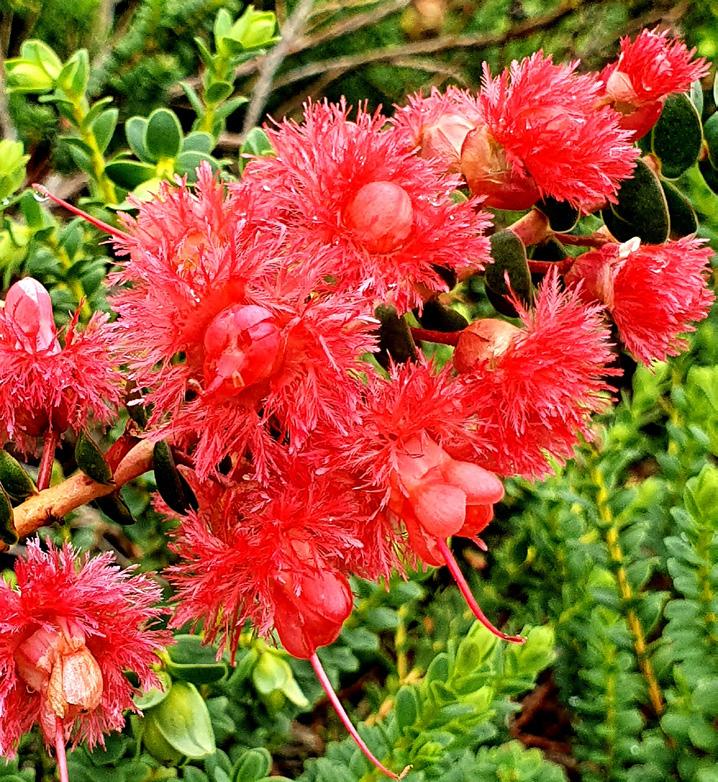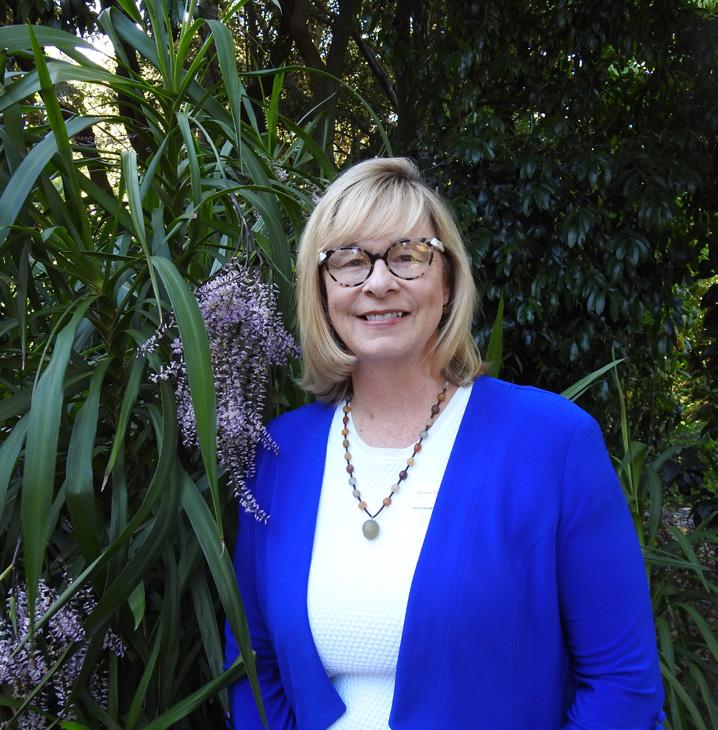
6 minute read
Plants in the Gardens
WE TAKE A LOOK AROUND THE BOTANIC GARDENS TO DISCOVER MORE ABOUT THE WONDERFUL PLANTS TO LOOK OUT FOR NEXT TIME YOU VISIT, AND EVEN SOME YOU CAN TAKE HOME TO YOUR OWN GARDEN ROYAL BOTANIC GARDEN SYDNEY the most rewarding time with plant growth and flowering at its peak. The tropical plants are enjoying the hot humid weather. The gingers are flowering prolifically, and Dichorisandra thyrsiflora, commonly known as blue ginger but more closely related to Commelina, puts on a stunning flowering display in several locations throughout the Garden in late summer. The lotus pond is at its best from November to January with the Nelumbo nucifera in full leaf and flowering. The wildflower meadow, with a pollinator-friendly mix of flowers, will
GARDEN focus
Advertisement
WAX PLANT, WAX FLOWER Hoya species Family Asclepiadaceae This is a genus of around 70 species of mainly climbing or twining evergreen plants named for Thomas Hoy, an 18th century head gardener at Syon House on the Thames opposite Kew Gardens. Most are twining climbers with fleshy, smooth rather rigid leaves that are generally dark green with a waxy texture. There is a very wide range of leaf shapes and sizes. The flowers too are waxy or fleshy with spreading petals surmounted by a central crown that may be yellow, white, red, pink or purple.
Best known and probably the most widely cultivated is Hoya carnosa (above) native to Southern China and India. It has small waxy white, starshaped flowers topped with a small pink crown, is night scented and quite vigorous once plants are well established. It does well trained on to lattice or other support but could also be used as a trailer. Australian species H. bella is a smaller grower with deep crimson, lightly-scented flowers which do well in a hanging basket. H. australis Australian species but are totally unalike. White flowered Hoya australis will grow in a hanging basket or on a trellis. Hoya macgillivrayi needs a sturdier support to display its large burgundy-red flowers. It needs glasshouse conditions or a very warm, sheltered position anywhere south of Brisbane. Hoya kerrii a species from South East Asia is grown for its large heart-shaped leaves and its flowers.
Plants should be grown in a sheltered, semi-shaded position in the ground or in containers. Containers should be just large enough to contain the root ball with 2–3 cms space around the perimeter. Whether in the ground or in containers, the growing medium must be free-draining. Margaret Hanks, Growing Friends, Royal Botanic Garden Sydney
WHERE YOU CAN FIND IT Although several species are cultivated by Growing Friends, not all are available all the time. Some varieties may be displayed in The Fernery from time to time. Summer is the busiest season for our horticulturists at the Royal Botanic Garden Sydney, but it's also
and H. macgillivrayi are two other be buzzing with precious pollinating insects. The flower display is amazing with over 1,600 square metres of meadow sown in August 2020. The Rose Garden will be putting on a spectacular flowering display with 122 rose cultivars to enjoy.
The Millettia grandis (below) at Henry Lawson gate is arguably the most spectacular of the flowering trees. In December the flowering should be at its peak and is well worth a look. Another wonderful tree at its best in January is the Magnolia grandiflora next to the Rose Garden which produces the largest flowers of all the magnolias and with a lovely lemon scent.



GROWING FRIENDS plants

AUSTRALIAN BOTANIC GARDEN The stunning Verticordia grandis (above) will be in flower this summer. Commonly known as Scarlet Featherflower, it is endemic to southwest Australia’s Geraldton Sandplains. Belonging to the family Myrtaceae, it shares the common characteristic of possessing a lignotuber with some species of Eucalypts. This feature has allowed some plants to regenerate after bushfires and to live up to 100 years old in the wild. This species flowers from August to February.
SIGNIFICANT TREE The Mons Oak Quercus robur North of the Conservatorium of Music is Lawn 57, dotted with trees planted to commemorate soldiers from several countries who died in WW1. These include an English oak, Quercus robur, planted in 1935 by the Squires (sons) of Mons, Belgium, in soil from the grave of an unknown British soldier. It was recorded that an apparition, later referred to as the Angel of Mons, appeared and changed the course of the battle. BLUE MOUNTAINS BOTANIC GARDEN Flowering in late summer, the cheery gold of a Rudbeckia (above) is hard to miss, shining like a light in either woodland, prairie, pasture or stream-side settings. At the top of the Blue Mountains Botanic Garden’s North American Woodland, Rudbeckia laciniata’s mass of bright yellow, shining ray florets is hard to miss, while it is the stature of Rudbeckia maxima which sets it apart, growing to almost two metres in height from a silver green ‘cabbage’ of basal leaves. It is their height, golden hue and prolific flowering which inspired Carl Linneas to name the genus Rudbeckia in honour of his friend and fellow botanist Olof Rudbeck. In North America Rudbeckia laciniata leaves were used as a food souce, and the blooms applied to soothe burns. One of the first plants to re-emerge after forest fires, Rudbeckias are a pioneer plant and a hardy perennial with long-lasting, golden blooms.

GROWING FRIENDS PLANT SALES
The Royal Botanic Garden Sydney Mon–Fri 11am–2pm, Sat 10am–2pm Closed 19 Dec–10 Jan
The Australian Botanic Garden Mount Annan Mon–Sun 9am–4pm Closed 25–26 Dec and 1 Jan
The Blue Mountains Botanic Garden Mount Tomah Plant Sales currently closed FABULOUS FRIENDS Customers appreciate the everchanging range and high quality plants on our sales benches. They enjoy our cottage ambience, good prices, value for money and the experienced, friendly service.
I would like to give you another slant on why Growing Friends is so special – their organisational and management structure. Growing Friends are all volunteers. We are organised into separate teams which operate as self-contained units on our own designated days. We follow processes and practices developed by Team Leaders and coordinating leaders of the Growing Friends. Decision-making is through collaboration, compromise and consensus. Each team adapts these decisions to suit their own strengths, yet the end outcome is a consistent output of quality plants. This result depends on the deep level of commitment of all Growing Friends to support the F&F and the Gardens. Our management practices emphasise on-the-ground delegation of responsibility to those carrying out the work, and cooperative evolution of processes and procedures to best fit the needs of the organisation.
The whole enterprise is under the auspices of the F&F who provide essential staff support with aspects such as marketing, finance, and front office services. It also receives strong and very welcome support from the Gardens’ staff. It has been an absolute privilege and pleasure to volunteer in such a wonderful project. Anne van Roekel, retiring Administration Coordinator, Growing Friends










